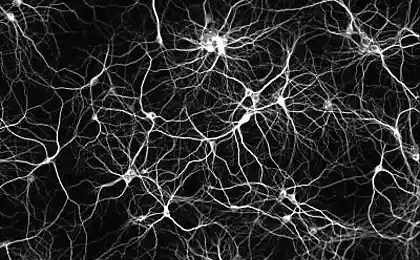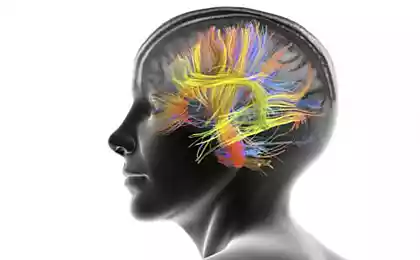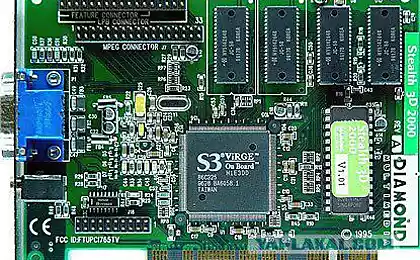9507
Schulte tables: a unique method of activation of the brain and the development of attention
Tables Schulte: develop attention
What is it like to table Schulte? Most often a table of 5x5 cells in which randomly placed numbers from 1 to 25. Designed table was to explore the properties of attention. Originally, and still used by psychologists for various studies. And in the process of working with these tables it was found that a simple "proveshivanie" they are a good influence on the development of memory and attention.
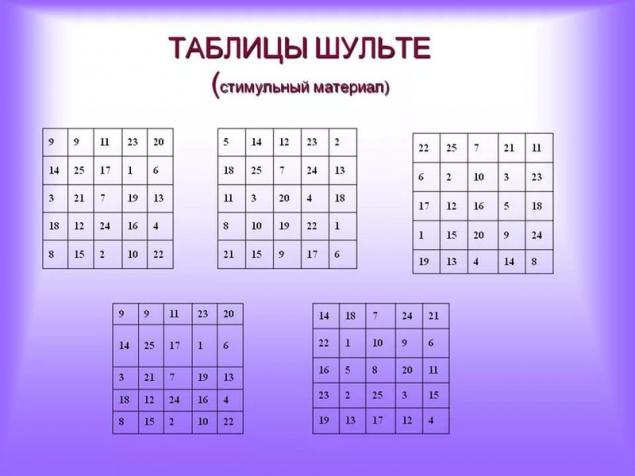
First and foremost, when working with tables Schulte a person develops a three-dimensional (parallel) attention, i.e. characters that are in your field of vision,you are perceived simultaneously, rather than read sequentially.
Second, working with tables Schulte in their state similar to meditation, which also has a positive effect on the intellectual development of man.
The essence of working with tables is finding a consistent look for all the numbers from 1 to 25 and it must be done in the shortest possible time.
1. Place the Schulte table at a comfortable distance from the eyes, as you have a book to read 30-40 cm
2. Find the square located at the center of the table and imagine that in the middle of it there is a point here on it and you need to fix the view.
3. Further, fixing the gaze on the center of the table, see figure 1. You need it to "see" and not "look". The main task is to find the cell with the number 1, without making eye movements.
4. Once found the unit, then slowly, continuing to stare at the center, look for a deuce, etc.
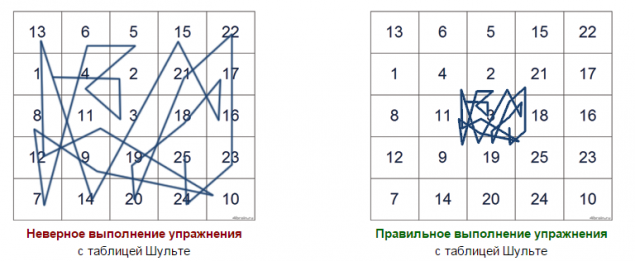
In the beginning, when working with tables, your eyes will behave as in Fig.1 But as you exercise, eye movements are becoming less and less intense. And their work is already such as in Fig.2
Regular work with Schulte tables will allow you to:
activate thought process and lead the mind to an active state;
to activate the memory;
to develop the skill of quick decision making.
During the training activates the frontal lobes of the cerebral cortex. This ensures the efficiency of all the intellectual processes that go on in the brain in the process of taking any decisions. This part of our brain responsible for how well we are able to organize their thoughts and actions in light of the goals we have set for ourselves. Also, those areas of the brain are considered to be the focus of the processes that underlie our attention.
Scientists have conducted various experiments in the field of functional neuroimaging. With instruments that recorded the intensity of blood flow in different parts of the cerebral cortex at the decision of subjects of different intellectual tasks (crosswords, Shulte tables, arithmetic problems, puzzles, etc.). By results of researches scientists have done two things:
When the subject was given some new task for him — it caused a substantial rush of blood to the frontal lobes of the cerebral cortex. If the problem is repeated, then the blood flow was significantly lower.
The intensity of the blood flow depended not only on the novelty of the task, but also on its nature. And the highest intensity was recorded when the subjects working with tables Schulte.
It was under the classroom tables, the maximum flow is in areas of the frontal lobes. And the brain is not distracted and does not waste resources on any additional costs, as was observed in solving arithmetic problems, memorizing poems or crossword puzzles.
Regular sessions with Schulte tables give a noticeable increase in memory and, perhaps more importantly, will significantly increase the speed of handling information within it.
P. S. And remember, just changing your mind — together we change the world! ©
Source: fitnessbrain.ru/razvitie-mozga/uprazhneniya-razvitie-mozga/tablitsa-shulte
What is it like to table Schulte? Most often a table of 5x5 cells in which randomly placed numbers from 1 to 25. Designed table was to explore the properties of attention. Originally, and still used by psychologists for various studies. And in the process of working with these tables it was found that a simple "proveshivanie" they are a good influence on the development of memory and attention.

First and foremost, when working with tables Schulte a person develops a three-dimensional (parallel) attention, i.e. characters that are in your field of vision,you are perceived simultaneously, rather than read sequentially.
Second, working with tables Schulte in their state similar to meditation, which also has a positive effect on the intellectual development of man.
The essence of working with tables is finding a consistent look for all the numbers from 1 to 25 and it must be done in the shortest possible time.
1. Place the Schulte table at a comfortable distance from the eyes, as you have a book to read 30-40 cm
2. Find the square located at the center of the table and imagine that in the middle of it there is a point here on it and you need to fix the view.
3. Further, fixing the gaze on the center of the table, see figure 1. You need it to "see" and not "look". The main task is to find the cell with the number 1, without making eye movements.
4. Once found the unit, then slowly, continuing to stare at the center, look for a deuce, etc.

In the beginning, when working with tables, your eyes will behave as in Fig.1 But as you exercise, eye movements are becoming less and less intense. And their work is already such as in Fig.2
Regular work with Schulte tables will allow you to:
activate thought process and lead the mind to an active state;
to activate the memory;
to develop the skill of quick decision making.
During the training activates the frontal lobes of the cerebral cortex. This ensures the efficiency of all the intellectual processes that go on in the brain in the process of taking any decisions. This part of our brain responsible for how well we are able to organize their thoughts and actions in light of the goals we have set for ourselves. Also, those areas of the brain are considered to be the focus of the processes that underlie our attention.
Scientists have conducted various experiments in the field of functional neuroimaging. With instruments that recorded the intensity of blood flow in different parts of the cerebral cortex at the decision of subjects of different intellectual tasks (crosswords, Shulte tables, arithmetic problems, puzzles, etc.). By results of researches scientists have done two things:
When the subject was given some new task for him — it caused a substantial rush of blood to the frontal lobes of the cerebral cortex. If the problem is repeated, then the blood flow was significantly lower.
The intensity of the blood flow depended not only on the novelty of the task, but also on its nature. And the highest intensity was recorded when the subjects working with tables Schulte.
It was under the classroom tables, the maximum flow is in areas of the frontal lobes. And the brain is not distracted and does not waste resources on any additional costs, as was observed in solving arithmetic problems, memorizing poems or crossword puzzles.
Regular sessions with Schulte tables give a noticeable increase in memory and, perhaps more importantly, will significantly increase the speed of handling information within it.
P. S. And remember, just changing your mind — together we change the world! ©
Source: fitnessbrain.ru/razvitie-mozga/uprazhneniya-razvitie-mozga/tablitsa-shulte





